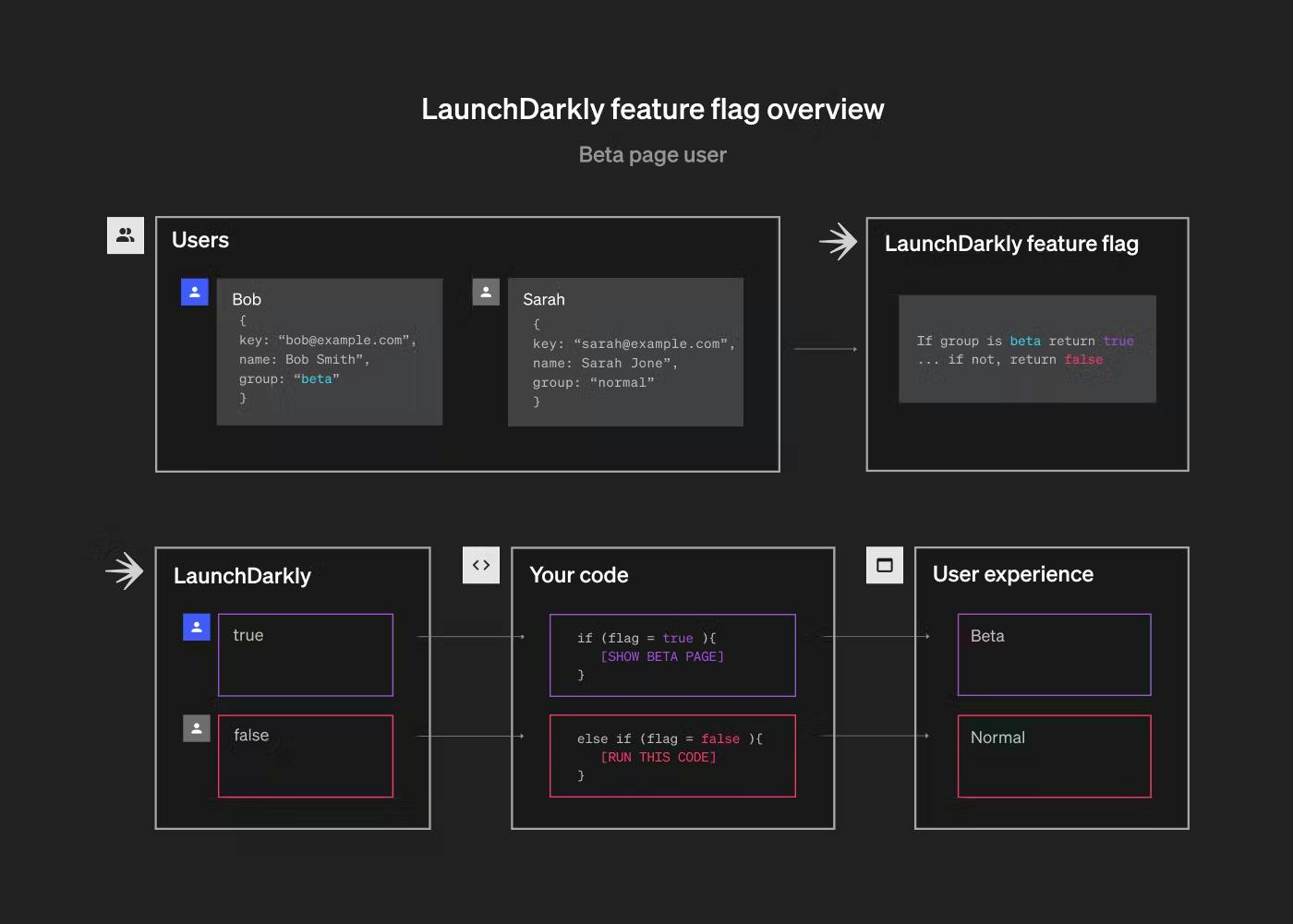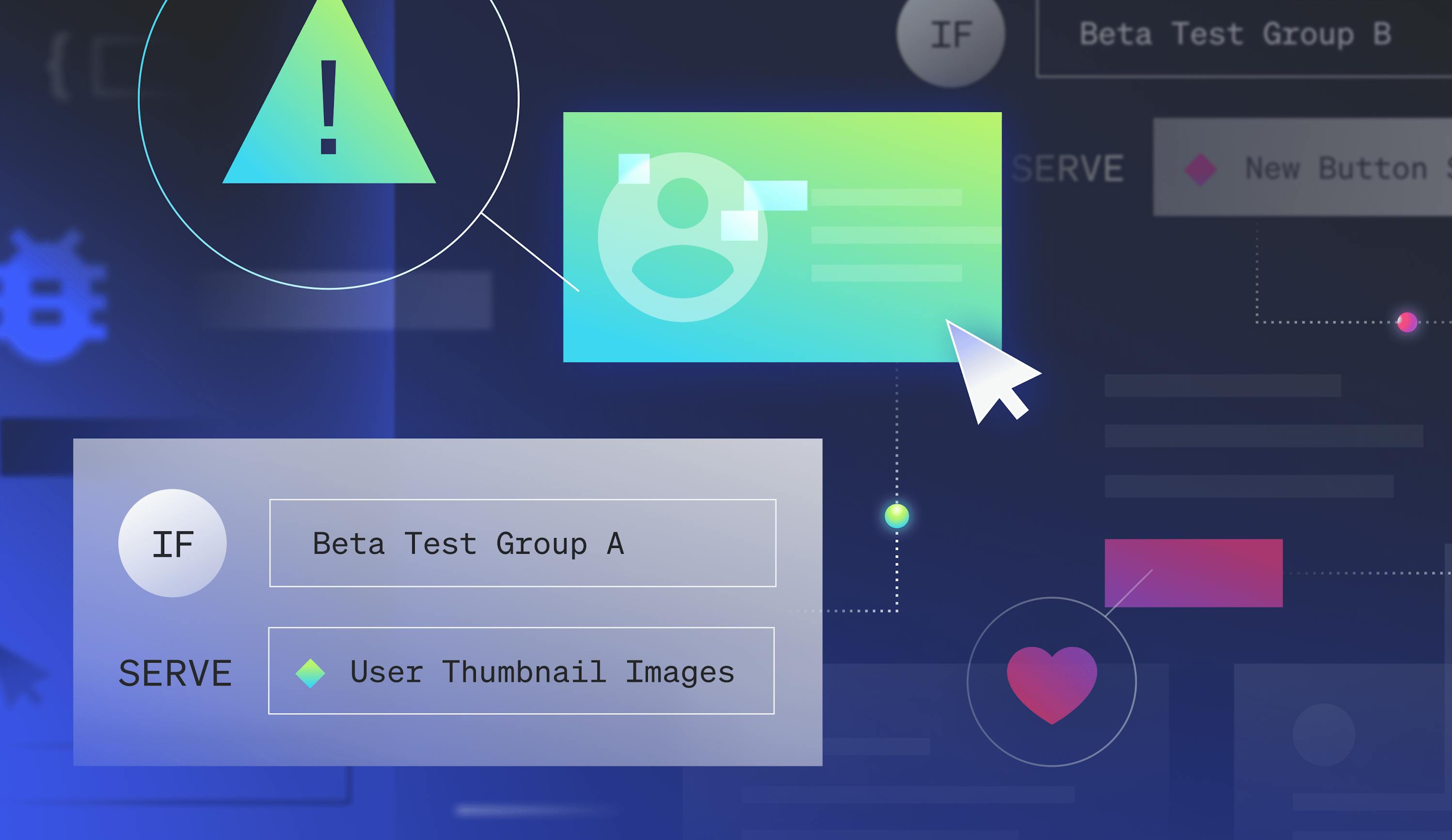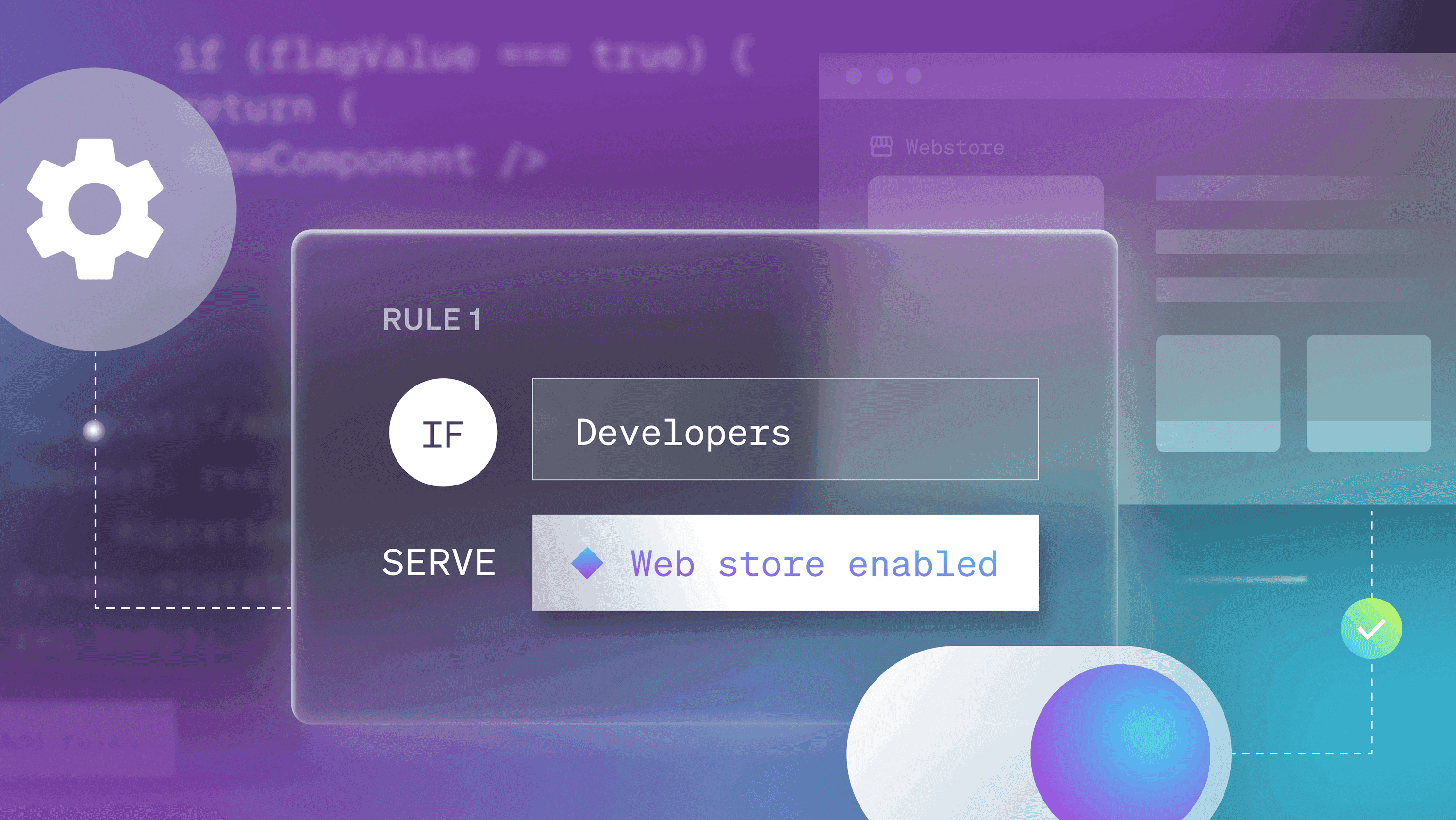Key Takeaways
- Beta testing programs enable you to offer access to new applications or features to a limited subset of users for testing and validation.
- Testing in production is an important part of minimizing bugs and issues while also ensuring that new features meet users’ expectations.
- There are three broad types of beta testing programs: internal betas; closed betas; and public betas.
- Feature flags can simplify the management of beta programs by allowing teams to enable and disable features based upon targeting rules.
What are beta testing programs?
A beta testing program is a repeatable process that product delivery teams employ to run beta tests in their software applications: websites, mobile apps, gaming consoles, kiosks, and so on. Beta testing is a part of the software testing process that involves making a pre-release version or beta version of a new product, new version of the existing application or of specific features within that application to a select group of users in a real environment. This controlled release helps your team gather real-world feedback from real users and identify potential issues before the official launch. It can also provide customer validation of new functionality and help improve overall product quality and, ultimately, improve customer satisfaction.
In this article, we'll look at what beta testing involves, the benefits it can offer and how you can implement it within your organization.
Why implement a beta testing program?
Software engineering has become incredibly complex. While companies keep working to improve their development practices and test plans, we all know that issues still commonly occur, despite teams performing unit testing, functional testing, regression testing, QA testing and, perhaps, more.
And it's not enough that a feature works. It also needs to be the right feature implemented in a way that meets the end user's expectations. It's not uncommon for companies to invest large sums in the development of a feature only to find that customers don't like it and/or don't use it.
Without real world testing, we might end up with:
- Limited user perspective. For example, our test users might not represent our target market.
- Undetected bugs and glitches. For example, our testing tools may not be able to test every variation of operating systems for our mobile app.
- Performance discrepancies that may only be discovered when running in production under a full traffic load.
- Inadequate user feedback and user acceptance testing.
It's not all doom and gloom, however. There are strategies that can help you avoid these situations. One of these strategies is beta testing in production.
Differences between alpha testing and beta testing
Alpha testing is typically conducted before beta testing and takes place in a controlled environment with testing being done by an internal testing team. Alpha testing is focused on identifying bugs and issues in the early stages of development. Beta testing comes after alpha testing and involves releasing the software to a select group of external users who represent the actual target audience in a real-world environment. Beta testing tends to be more focused on real-world usage scenarios and user feedback.
As you might imagine, managing access to alpha testing is relatively straightforward due to its controlled environment, but, with beta testing, things can get trickier. This is especially true if you are beta testing individual features rather than an entire application.
Benefits of beta testing
Beta testing offers a ton of benefits, and not just to your developers.
- For developers: Identify bugs and issues that weren't caught by other forms of testing with a limited audience, thereby reducing the impact of those issues and allowing time for them to be corrected, without requiring the immediate response of a typical production incident. It also allows developers to validate that features meet the user's expectations by getting direct user feedback.
- For businesses: Beta testing provides insights from a diverse user base, ensuring a more comprehensive understanding of user needs than can be provided by alpha testing. Internal testers are often too close to the product to provide the kind of feedback a beta tester can. Beta testing feedback doesn't just address bugs but can provide insights that improve the user experience. It can create incentives for brand loyalty by giving users a say and a stake in the success of a product while also generating buzz and anticipation for the launch.
- For users: Early access to new features not only gives users insight into what's coming so that they can plan ahead and take advantage of new capabilities on day one, but it also gives them influence on product development and direct access to product stakeholders within the company.
Common types of beta tests
While there is no one-size-fits-all formula for beta tests, there are three broad types of beta tests that you might consider using:
- Internal beta – As the name implies, this beta test is done within the company and is available to all employees or a subset of employees. It differs from an alpha test in that the participants are not trained testers and the test occurs in production rather than a controlled testing environment. While internal betas can be helpful, they tend to limit the range of feedback you might receive and some testers might feel uncomfortable being overly critical of work done by their colleagues.
- Closed beta testing – This type of beta test involves external users who are either selected to participate because they are product experts/power users, match some specific demographic criteria or who have specifically opted into a beta access group. A closed beta can give you the honest feedback from actual customers that you need while keeping the beta group size and quantity of feedback manageable. However, it is unlikely to generate significant buzz or anticipation in the general community due to its smaller scale.
- Open beta or public beta – An open beta is available to anyone who wants to participate. In some cases the beta features are publicly available but marked as beta and in others there is an open opt-in to a beta group that has no restrictions on who can join. An open beta is, by its nature, a large group of external users and thus can result in a lot of useful feedback as well as generate a lot of buzz around new features. The drawback is that the feedback may not be as high quality as either the internal or closed betas.
It's important to point out that you do not need to choose just one of these strategies. An effective strategy might involve all three, broadening the access from internal to closed then to open. This also ensures that by the time features hit the open beta, they are battle tested and can generate the positive anticipation that you want.
Challenges of beta programs
While the benefits of beta programs far outweigh any difficulties, there are some logistical challenges you need to plan for when organizing a beta program.
- Managing members: It can be difficult to manage who has access to beta features. For example, in a closed beta, someone needs to coordinate and assign users to the beta group. Often this falls on a product manager, product marketing manager or community manager to handle. Meanwhile there are demands on engineering who need to build a way to ensure only the selected users see the beta features or perhaps, build a way for users to opt in to the beta access.
- Collecting feedback: During the beta testing phase, there are two aspects of feedback that require some planning and execution. First, you'll need to consider how beta participants will submit their feedback. You should consider a special for, community channel or GitHub issues board for beta feedback so as not to overload your existing support channels. Second, you'll need to determine how to organize and act upon that feedback. Bugs might go through your traditional ticket system but what about feedback regarding user experience? Depending on the size of your beta access group, you may have a significant amount of feedback that needs to be collated and put into some format that is actionable.
The importance of testing in production
Beta testing should occur in production. Production testing provides the most accurate and relevant data about user experience, usability and feature metrics in a live, real-world environment. It’s difficult to recreate the behavior and expectations of organic users with synthetic users on an isolated testbed. If you want to understand the impact of a new feature on your users, the best way to find out is to deliver it to them.
Rather than slow down your release processes, testing in production can actually increase them. This may seem counterintuitive, but consider how bugs and issues that are caught as production incidents can cause major disruptions to your development processes and take resources away from work on the next release.
Testing in production using beta releases combined with progressive rollouts can ensure quicker identification and resolution of bugs and issues while limiting their "blast radius". This can prevent costly incidents while ultimately reducing the risk and cost of releasing new features.
Better beta testing with feature flags
Feature flags can be a perfect tool for managing the beta testing process, depending on the capabilities of your feature flagging solution. By design feature flags are built for testing in production. Many feature flag services also provide advanced targeting capabilities that would allow you to easily manage individual beta members, target features based on demographic criteria and progressively roll out your features to new groups and segments. This means that you can use feature flags to more easily roll out beta access without the need to maintain a specific beta environment.

Image caption: We add Bob and Sarah to a beta audience segment in LaunchDarkly. Then we use a feature flag and targeting rules to release a beta feature to the beta group only.
Plus, feature flags can open up a ton of other capabilities that can improve your overall development processes such as:
- A/B testing and experimentation: This allows you to compare different feature variations to determine the optimal version based on user behavior and performance data. This can be combined with beta testing to help you make better decisions regarding feature releases.
- Canary releases: Like beta testing, a canary release is when you make features available to a limited selection of users ahead of a wider release. Sometimes these are targeted but they can also be based upon random percentages.
- Dark launches: A dark launch is when a feature exists in your production code but is not visible in production, though it may be visible in other environments. This allows your team to practice trunk-based development, helping them to eliminate the need for complex branching strategies and maintaining multiple development and testing environments while reducing or eliminating complex merges.
Feature flags allow you to decouple deploy from release, meaning that just because a feature's code has been deployed doesn't mean the feature has been released. Plus, feature flags make it easy to quickly or even instantly rollback a release should an issue arise, dramatically limiting the size and scale of any incidents.
Beta testing success stories
Many companies have adopted beta testing as part of their overall release and testing strategy. Let's explore a handful of examples.
Atlassian's beta testing uses feature flags to create cohorts of users based upon demographic or other criteria and then offer different features in a highly targeted fashion. By using feature flags for enabling and disabling beta feature access, product management is able to independently run beta tests without requiring the intervention of their development team and gather feedback on new features and product usage.
Given the nature of Seesaw's software for managing student portfolios, their beta testing often takes place in the classroom. They use feature flags to enable and disable features during these tests and are able to collect valuable feedback that helps them improve their product, as their product manager Emily Voigtlander explained:
"We typically visit a classroom, turn the flags on for the hour we are there, run the study with the students, then turn the flags off – at which point, students reverted to the older version of Seesaw. Students are often sad when we turn the flags off. When we run these user tests, not only do we get helpful observational data, but we also get feature requests directly from our student customers. Tons of useful feedback comes out of these classroom sessions."
Beta tests allow Reciprocity to take a data-driven approach to feature development and avoid putting a lot of time and effort into the development of features that yield low engagement. Beta testing also allows them to give early adopter customers that are eager for new functionality access to the latest in development features while keeping those with less of an appetite for change on more predictable release cycles.
LaunchDarkly’s approach to beta testing
The benefits of beta testing are clear. Using beta testing, you can enable your engineering and product management teams to improve overall feature development to deliver features your users will love while also avoiding releasing features that either don't work or aren't used. We've also seen that feature flags can make it easy to manage beta testing cohorts, provided your feature flagging system offers the right capabilities.
That's where LaunchDarkly comes in. LaunchDarkly's feature management platform offers the most advanced, context-based targeting capabilities, allowing you to target your beta features to exactly the right sets of users without worry of impacting anyone else. Plus, LaunchDarkly makes it easy for engineers and non-engineers alike to manage flags, segments and targeting. This means that your product management team won't need to rely upon the time of engineers to develop their beta cohorts and manage access to beta features.
By making it easy for your team to create and manage beta tests, LaunchDarkly can not only help you improve the outcomes of your development but even speed up feature releases. If you'd like to learn more about how LaunchDarkly can help you start or improve your beta testing capabilities, request a demo.
















.png)

.png)





